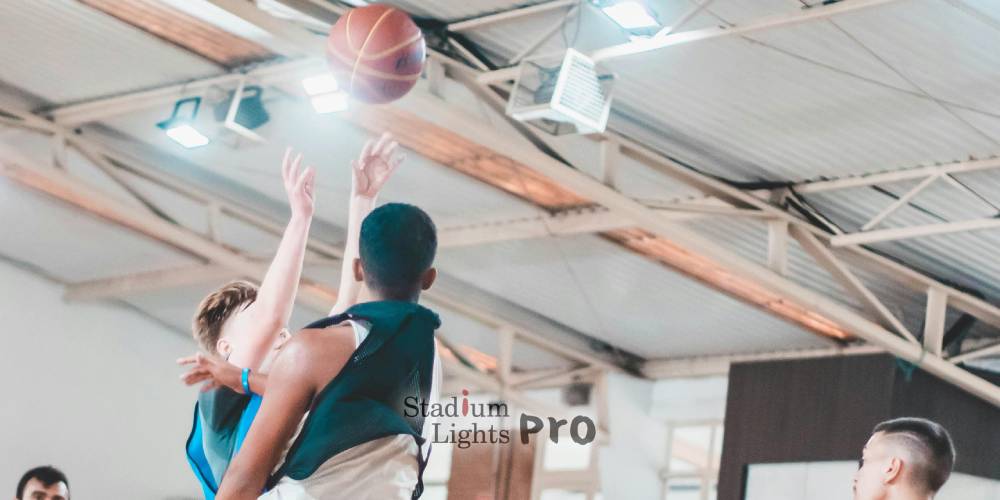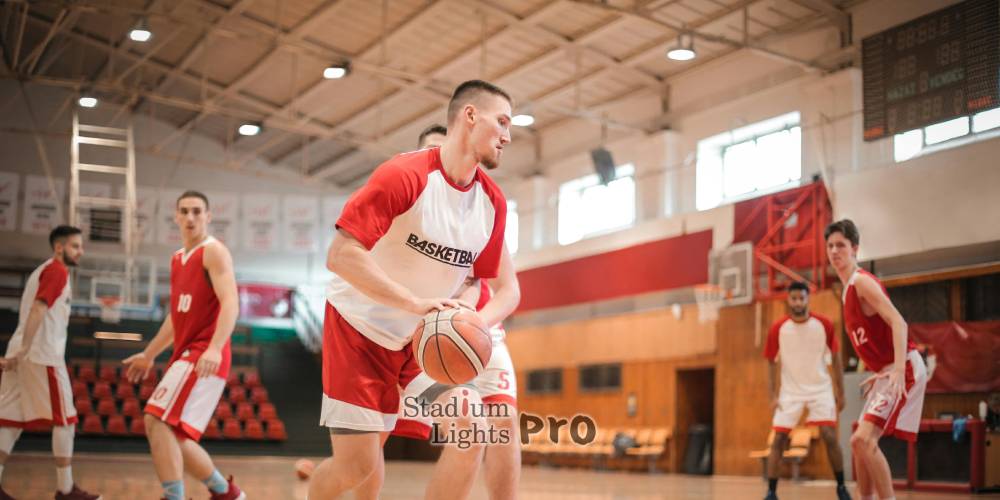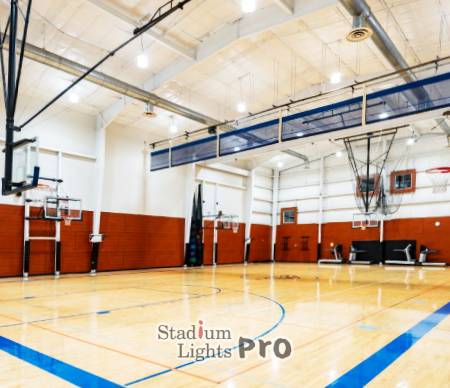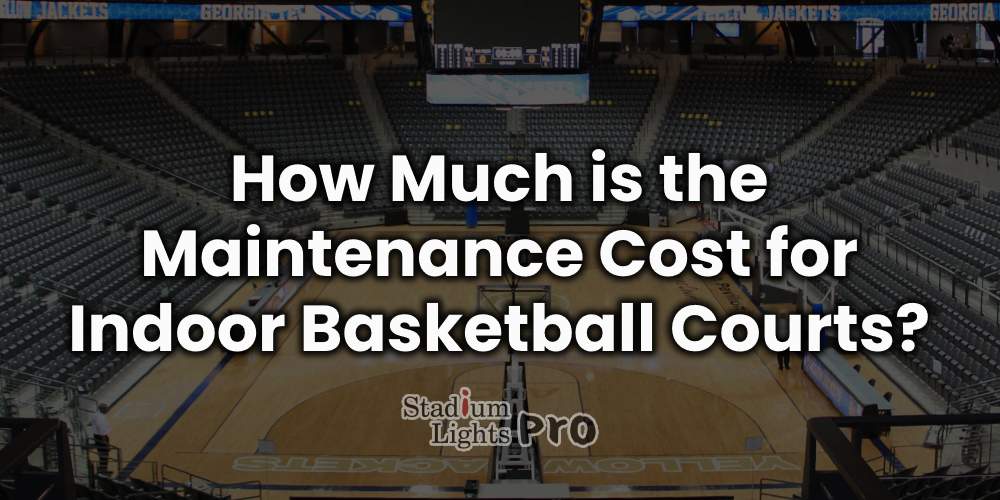From routine cleaning to repairing wear and tear, maintenance plays a crucial role in preserving the integrity of the facility and providing a conducive environment for gameplay. Introducing LED lighting to indoor basketball courts further enhances the maintenance paradigm, offering energy-efficient, long-lasting illumination that not only reduces operational costs but also contributes to player performance and safety. LED lighting’s relevance lies in its ability to optimize visibility, minimize maintenance requirements, and provide consistent lighting levels, thus underscoring its importance in the broader context of indoor basketball court maintenance.

Table of Contents
ToggleFactors Influencing Maintenance Costs
Court size and materials
Court size and materials refer to key factors influencing the maintenance costs of indoor basketball courts. The size of the court directly impacts the amount of wear and tear it experiences, with larger courts typically requiring more frequent maintenance. Additionally, the materials used in the construction of the court, such as hardwood, synthetic flooring, or rubber surfaces, significantly affect maintenance needs and costs. Hardwood floors, while offering excellent performance and aesthetics, often require periodic refinishing and resurfacing to maintain their quality, contributing to higher maintenance expenses. Conversely, synthetic or rubber surfaces may require less intensive maintenance but still incur costs for regular cleaning and repairs. Understanding the relationship between court size and materials is essential for effectively managing maintenance budgets and ensuring the long-term sustainability of indoor basketball courts.
Frequency of use
The frequency of use is a critical factor influencing the maintenance costs of indoor basketball courts. Courts that experience high levels of usage, such as those in schools, community centers, or sports complexes hosting multiple events and games daily, incur more wear and tear, leading to increased maintenance needs and costs. Regular practices, tournaments, and open gym sessions contribute to the accumulation of dirt, debris, and potential damage to the court surface, necessitating more frequent cleaning, repairs, and replacements of equipment. Conversely, courts with lower usage may require less maintenance, resulting in reduced overall costs. Understanding the impact of usage frequency is essential for developing effective maintenance schedules and budgeting resources to ensure the continued functionality and safety of indoor basketball courts.
Climate and environmental factors
Climate and environmental factors play a significant role in determining the maintenance costs of indoor basketball courts. While these facilities are enclosed, external conditions can still affect their upkeep. Facilities located in regions with high humidity levels may experience moisture-related issues such as mold growth or wood warping, necessitating specialized maintenance and remediation efforts. Extreme temperatures can also impact the condition of the court surface, particularly if it is made of materials sensitive to temperature changes. Besides, indoor courts situated in areas prone to dust, pollen, or other airborne particles may require more frequent cleaning to maintain a safe and sanitary playing environment. Understanding the local climate and environmental conditions is essential for implementing proactive maintenance strategies that mitigate potential damage and ensure the long-term durability of indoor basketball courts.
Type of flooring
The type of flooring used in indoor basketball courts is a critical factor influencing maintenance costs. Different flooring materials, such as hardwood, synthetic surfaces, or rubber flooring, have varying maintenance requirements and associated costs. Hardwood floors, while providing excellent performance and aesthetics, require regular refinishing and resurfacing to maintain their quality and appearance, contributing to higher maintenance expenses. Synthetic surfaces, such as polyurethane or vinyl, offer durability and easier maintenance compared to hardwood, typically requiring regular cleaning and occasional repairs. Rubber flooring, often used in multipurpose courts, is resilient and low-maintenance but may still require periodic cleaning and maintenance to ensure optimal performance. Understanding the characteristics and maintenance needs of different flooring types is essential for effectively managing maintenance budgets and preserving the integrity of indoor basketball courts.
Impact of lighting systems, with emphasis on LED lighting
The impact of lighting systems, particularly with an emphasis on LED lighting, is significant in determining the maintenance costs and overall performance of indoor basketball courts. LED lighting offers numerous advantages over traditional lighting sources, including higher energy efficiency, longer lifespan, and superior quality of light. By reducing energy consumption and minimizing the need for frequent bulb replacements, LED lighting can lead to substantial cost savings in terms of both electricity bills and maintenance expenses. LED lights provide consistent illumination levels with minimal glare, ensuring optimal visibility for players and spectators alike. Moreover, the durability of LED fixtures reduces the likelihood of malfunctions or failures, further decreasing maintenance requirements. Embracing LED lighting technology not only enhances the sustainability and cost-effectiveness of indoor basketball court operations but also contributes to an improved playing experience for athletes and enhances safety within the facility.

Understanding LED Lighting for Indoor Basketball Courts
Advantages of LED lighting
The advantages of LED lighting are manifold, particularly in the context of indoor basketball courts. Firstly, LED lighting is highly energy-efficient, consuming significantly less electricity compared to traditional lighting sources such as incandescent or fluorescent bulbs. This results in lower energy bills and reduced overall operational costs for the facility. Moreover, LED lights have a much longer lifespan than conventional bulbs, lasting up to 25 times longer on average. This longevity minimizes the frequency of bulb replacements, thereby reducing maintenance costs and the inconvenience of downtime for lighting fixture repairs. Moreover, LED lights emit bright, uniform illumination with excellent color rendering, enhancing visibility on the court and improving the overall playing experience for athletes. Furthermore, LED technology allows for precise control of lighting levels and distribution, enabling facilities to tailor lighting conditions to meet specific needs, such as optimizing visibility for televised games or reducing glare during practice sessions. Overall, the advantages of LED lighting make it a highly attractive and cost-effective choice for illuminating indoor basketball courts.
Energy efficiency and cost savings
Energy efficiency and cost savings are key advantages of LED lighting, especially in indoor basketball courts. LED lights consume significantly less energy than traditional lighting sources, such as incandescent or fluorescent bulbs, while still providing bright and uniform illumination. This increased efficiency translates to substantial reductions in electricity consumption, resulting in lower energy bills for the facility. Additionally, LED lights have a longer lifespan, lasting up to 25 times longer than conventional bulbs. This means fewer replacements are needed over time, reducing maintenance costs associated with purchasing and installing new bulbs. Furthermore, the superior durability of LED lights minimizes the risk of breakage or damage, further lowering maintenance expenses. Overall, the energy efficiency and cost savings offered by LED lighting make it a highly desirable option for illuminating indoor basketball courts, allowing facilities to allocate resources more effectively and sustainably.
Longevity and durability
Longevity and durability are standout features of LED lighting, particularly beneficial for indoor basketball courts. LED lights have a significantly longer lifespan compared to traditional lighting sources, lasting up to 25 times longer on average. This extended lifespan translates to fewer replacements over time, reducing maintenance costs and the inconvenience of frequent bulb changes. Furthermore, LED lights are inherently durable, constructed with solid-state components that are less prone to breakage or damage from shock or vibration. This durability makes LED lighting fixtures well-suited for the dynamic environment of indoor basketball courts, where activities such as dribbling, jumping, and ball impacts occur regularly. Furthermore, LED lights operate efficiently across a wide range of temperatures, ensuring reliable performance even in challenging indoor environments. Overall, the longevity and durability of LED lighting make it a reliable and cost-effective choice for illuminating indoor basketball courts, providing consistent illumination for years to come.
Quality of light for optimal gameplay
The quality of light provided by LED lighting is crucial for optimal gameplay on indoor basketball courts. LED lights offer several advantages that contribute to a superior playing experience for athletes and spectators alike. Firstly, LED lights produce bright, uniform illumination that enhances visibility across the entire court, ensuring players can see clearly and react quickly to movements and actions. This consistent lighting helps reduce shadows and glare, creating a more comfortable and visually appealing environment for gameplay. In addition, LED lights have excellent color rendering capabilities, accurately reproducing the vibrant colors of team uniforms, basketballs, and court markings. This ensures that players can easily distinguish between different elements on the court, facilitating precise positioning and decision-making during games. Furthermore, LED lighting fixtures can be easily dimmed or adjusted to suit different lighting needs, such as during practice sessions or televised events, providing flexibility and adaptability to accommodate various gameplay scenarios. Overall, the quality of light provided by LED lighting contributes to an optimal playing experience on indoor basketball courts, promoting safety, visibility, and performance for all involved.
Common Maintenance Tasks and Costs
| Maintenance Task | Description | Timeframe | Price Range (USD) |
|---|---|---|---|
| Routine Cleaning and Sweeping | Regular cleaning of the court surface to remove dust and debris, ensuring safety and cleanliness. | Weekly or Bi-weekly | $100 – $300 |
| Floor Refinishing and Resurfacing | Refinishing or resurfacing the court floor to repair scratches, scuffs, and imperfections, maintaining a smooth playing surface. | Every 1-2 years | $500 – $2000 |
| Repairing or Replacing Flooring | Patching or replacing damaged sections of the court flooring to ensure safety and structural integrity. | As needed | $200 – $1000 |
| Inspecting and Maintaining LED Lighting Fixtures | Regular inspection and maintenance of LED lighting fixtures to ensure optimal performance and longevity. | Annually | $50 – $200 |
| HVAC System Maintenance for Temperature Regulation | Maintenance and servicing of HVAC systems to regulate indoor air quality and temperature, ensuring player comfort. | Semi-annually | $200 – $500 |
| Preventive Maintenance Programs for LED Lighting | Scheduled inspections, cleaning, and maintenance tasks for LED lighting fixtures to prevent issues and maximize lifespan. | Quarterly | $100 – $300 |
| Total | $1150 – $4300 |
Routine cleaning and sweeping
Routine cleaning and sweeping are essential maintenance tasks for indoor basketball courts to ensure optimal playing conditions and safety for athletes. Regular cleaning helps remove dust, dirt, and debris that can accumulate on the court surface, preventing slip hazards and maintaining traction for players. This involves sweeping the entire court area with a soft-bristled broom or specialized floor sweeper to remove loose particles. Moreover, wet mopping with a mild detergent solution may be necessary to remove stubborn stains or spills and maintain cleanliness. Routine cleaning not only enhances the appearance of the court but also prolongs the lifespan of the flooring material by preventing abrasive particles from causing premature wear and tear. Moreover, regular maintenance promotes a healthy indoor environment by reducing the buildup of allergens and contaminants, ensuring a hygienic space for athletes to train and compete. Overall, routine cleaning and sweeping are fundamental maintenance practices that contribute to the longevity and performance of indoor basketball courts.
Floor refinishing and resurfacing
Floor refinishing and resurfacing are critical maintenance tasks for indoor basketball courts to ensure a smooth and safe playing surface for athletes. Over time, the constant foot traffic, impacts from basketballs, and general wear and tear can cause the court’s flooring to degrade, resulting in surface imperfections, scratches, and scuffs. Floor refinishing involves stripping away the existing finish and applying a new coat of sealant or finish to restore the flooring’s appearance and protect it from further damage. This process helps to fill in minor cracks and imperfections, smooth out uneven surfaces, and enhance the durability of the flooring material. Additionally, in cases where the court’s surface has become significantly worn or damaged, resurfacing may be necessary. Resurfacing typically involves sanding down the existing flooring material to remove deep scratches and gouges before applying a new layer of surfacing material, such as polyurethane or epoxy, to create a fresh, uniform surface. Floor refinishing and resurfacing not only improve the aesthetics of the court but also contribute to player safety by reducing the risk of slips, trips, and falls. These maintenance tasks are typically performed periodically as part of a comprehensive maintenance plan to ensure the long-term integrity and performance of indoor basketball courts.
Repairing or replacing flooring
Repairing or replacing flooring is a crucial aspect of maintenance for indoor basketball courts to ensure player safety and preserve the integrity of the playing surface. Over time, the flooring of indoor basketball courts may develop signs of wear and tear, such as cracks, warping, or unevenness, which can compromise the playing experience and increase the risk of injuries to athletes. In cases where minor damage occurs, repairs may be sufficient to address the issue. This can involve patching or filling in cracks, smoothing out uneven surfaces, or replacing individual sections of damaged flooring material. However, if the damage is extensive or compromises the structural integrity of the court, replacement of the flooring may be necessary. This typically involves removing the existing flooring material and installing a new surface, such as hardwood, synthetic flooring, or rubber, to restore the court to its original condition. Whether repairing or replacing flooring, it is essential to use high-quality materials and employ skilled professionals to ensure the longevity and performance of the indoor basketball court. Regular inspection and maintenance of the flooring help identify issues early and prevent more significant problems from arising, ultimately prolonging the lifespan of the court and providing a safe and enjoyable playing experience for athletes.
Inspecting and maintaining LED lighting fixtures
 Inspecting and maintaining LED lighting fixtures is crucial for ensuring optimal illumination and functionality within indoor basketball courts. Regular inspections help identify any issues or abnormalities with the lighting system, such as flickering lights, dimming, or burnt-out bulbs, which may affect visibility and safety on the court. Maintenance tasks typically include cleaning the fixtures to remove dust and debris that can accumulate over time and diminish light output. Besides, it is essential to check for loose connections, damaged wiring, or signs of wear and tear that may indicate potential hazards or performance issues. If any problems are detected during inspections, prompt repairs or replacements should be undertaken to address the issue and prevent further damage or malfunctions. Implementing a proactive maintenance schedule for LED lighting fixtures helps ensure consistent and reliable performance, enhances player visibility, and promotes energy efficiency within indoor basketball courts.
Inspecting and maintaining LED lighting fixtures is crucial for ensuring optimal illumination and functionality within indoor basketball courts. Regular inspections help identify any issues or abnormalities with the lighting system, such as flickering lights, dimming, or burnt-out bulbs, which may affect visibility and safety on the court. Maintenance tasks typically include cleaning the fixtures to remove dust and debris that can accumulate over time and diminish light output. Besides, it is essential to check for loose connections, damaged wiring, or signs of wear and tear that may indicate potential hazards or performance issues. If any problems are detected during inspections, prompt repairs or replacements should be undertaken to address the issue and prevent further damage or malfunctions. Implementing a proactive maintenance schedule for LED lighting fixtures helps ensure consistent and reliable performance, enhances player visibility, and promotes energy efficiency within indoor basketball courts.
HVAC system maintenance for temperature regulation
HVAC system maintenance for temperature regulation is essential to creating a comfortable and conducive environment for athletes and spectators within indoor basketball courts. HVAC systems are responsible for regulating indoor air quality, humidity levels, and temperature, ensuring optimal conditions for gameplay and overall comfort. Regular maintenance of HVAC systems involves several key tasks, including inspecting and cleaning air filters to ensure efficient airflow and prevent the buildup of dust and debris that can compromise system performance. Additionally, it is essential to check and calibrate thermostats and controls to maintain consistent temperature levels throughout the facility. Routine inspection of ductwork, vents, and fans helps identify and address any obstructions or airflow issues that may impede proper ventilation and circulation. Furthermore, scheduling periodic servicing and tune-ups by qualified HVAC technicians can help identify potential problems early and prevent costly breakdowns or malfunctions during peak usage periods. By prioritizing HVAC system maintenance, indoor basketball courts can ensure a comfortable and enjoyable experience for players and spectators while optimizing energy efficiency and minimizing operational costs.
Strategies for Cost Reduction
Implementing LED lighting upgrades
Implementing LED lighting upgrades is a proactive and cost-effective strategy for enhancing indoor basketball court facilities. LED lighting offers numerous advantages over traditional lighting sources, including higher energy efficiency, longer lifespan, and superior quality of light. Upgrading to LED lighting fixtures not only reduces energy consumption and lowers utility bills but also minimizes maintenance requirements due to the extended lifespan of LED bulbs. LED lights provide bright, uniform illumination with excellent color rendering, improving visibility and enhancing the overall playing experience for athletes. Furthermore, LED lighting fixtures can be easily integrated with advanced lighting control systems, allowing for precise adjustments to meet specific lighting needs and preferences. By investing in LED lighting upgrades, indoor basketball court facilities can achieve significant cost savings, improve sustainability, and create a safer and more enjoyable environment for players and spectators alike.
Preventive maintenance programs for LED lighting
Implementing preventive maintenance programs for LED lighting is essential for maximizing the performance and lifespan of lighting fixtures within indoor basketball courts. These programs involve scheduled inspections, cleaning, and maintenance tasks designed to identify and address potential issues before they escalate into more significant problems. Regular inspections help ensure that LED lighting fixtures are operating efficiently and effectively, with technicians checking for any signs of wear, damage, or malfunction. Cleaning the fixtures removes dust, dirt, and debris that can accumulate over time and diminish light output, ensuring consistent illumination levels. Moreover, preventive maintenance may include tasks such as tightening loose connections, replacing worn components, and updating firmware or software to optimize performance. By proactively addressing maintenance needs, preventive maintenance programs help minimize downtime, reduce repair costs, and prolong the lifespan of LED lighting fixtures, ultimately enhancing the overall reliability and functionality of indoor basketball court facilities.
Energy-efficient practices to reduce overall maintenance costs
Implementing energy-efficient practices is a strategic approach to not only lower energy consumption but also reduce overall maintenance costs for indoor basketball courts. Switching to LED lighting fixtures significantly reduces energy usage and lowers maintenance costs due to their long lifespan and durability. Additionally, installing occupancy sensors ensures lights are only activated when needed, minimizing unnecessary energy consumption. Regular maintenance and optimization of HVAC systems improve energy efficiency and reduce the likelihood of breakdowns or malfunctions. Smart building management systems allow for centralized control and monitoring of energy usage, enabling facility managers to identify areas of inefficiency and implement corrective measures promptly. Employee training and awareness initiatives foster a culture of energy efficiency, promoting accountability and reinforcing energy-saving behaviors. By incorporating these energy-efficient practices into maintenance routines, indoor basketball court facilities can significantly reduce their overall energy consumption and maintenance costs while creating more sustainable and environmentally friendly operations.
Budget allocation and planning
Budget allocation and planning play a crucial role in managing maintenance costs for indoor basketball courts effectively. It involves strategically allocating financial resources to cover routine maintenance tasks, repairs, upgrades, and unforeseen expenses while ensuring the long-term sustainability of the facility. By establishing a comprehensive maintenance budget, facility managers can prioritize essential maintenance activities based on their impact on safety, functionality, and cost-effectiveness. This includes allocating funds for regular cleaning, inspection, and servicing of equipment, as well as setting aside reserves for potential emergencies or major repairs. Furthermore, budget planning involves forecasting future maintenance needs and identifying opportunities for cost-saving measures, such as implementing energy-efficient technologies or preventive maintenance programs. By carefully managing budget allocation and planning, indoor basketball court facilities can optimize their resources, minimize operational expenses, and maintain high-quality standards for the benefit of athletes, staff, and spectators alike.
Conclusion
Maintaining indoor basketball courts involves a multifaceted approach that encompasses various factors, from routine cleaning to implementing advanced technologies like LED lighting. LED lighting upgrades offer significant benefits, including energy efficiency, longevity, and improved gameplay experience, while preventive maintenance programs ensure the optimal performance of lighting fixtures over time. Additionally, energy-efficient practices such as HVAC system optimization and budget allocation and planning are essential for reducing overall maintenance costs and promoting sustainability within indoor basketball court facilities. By adopting these strategies, facility managers can effectively manage maintenance expenses, enhance player safety and experience, and ensure the long-term viability of indoor basketball courts as vibrant community spaces for athletes and spectators alike.

